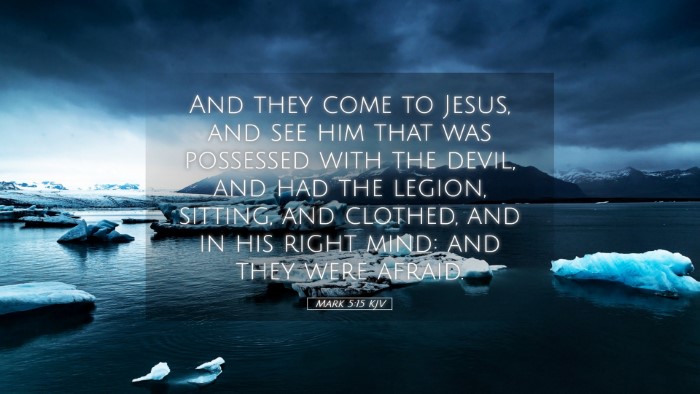Commentary on Mark 5:15
Mark 5:15 (KJV) reads: “And they come to Jesus, and see him that was possessed with the devil, and had the legion, sitting, and clothed, and in his right mind: and they were afraid.” This powerful verse follows the miraculous healing of a man possessed by a legion of demons. In this commentary, we will examine the significance of this transformation, the response of the crowd, and the implications of Jesus' mighty works, synthesizing insights from prominent public domain commentaries.
1. The Context of the Miracle
In the preceding verses, Jesus crosses the Sea of Galilee and encounters a man whose life has been tragically impacted by demonic possession. This man lived among the tombs, symbolizing both physical and spiritual death. The journey to this encounter is significant; it illustrates Jesus' mission to reach out to those who are marginalized and tormented by the powers of evil.
1.1. Matthew Henry's Insight
Matthew Henry notes that the miracle demonstrates the power of Christ over unclean spirits, indicating that the demons recognize His authority. He emphasizes the desolation that sin brings into the life of an individual, contrasting it with the peace that comes through Christ. The man was portrayed as a wild, uncontrollable figure, much like a society suffering from the consequences of sin.
1.2. Albert Barnes' Perspective
Albert Barnes remarks on the significance of Christ's approach to this afflicted man. The act of Jesus casting out the demons is a foreshadowing of His ultimate triumph over sin and Satan. Barnes also highlights the multitude of the demons (‘Legion’) as a representation of the comprehensive nature of evil that can afflict humanity.
1.3. Adam Clarke's Commentary
Adam Clarke provides a thorough analysis of the historical context of demonic possession and acknowledges the diverse understandings of spirits in Jewish culture. He elucidates the unique ability of Jesus to confront and bind the strongman (Satan) as described in Luke 11:21-22. Clarke's commentary emphasizes the notion of redemption and restoration for the man, as it speaks to God's intent to make whole the broken.
2. The Transformation of the Man
Upon encountering Jesus, the formerly possessed individual is found sitting, clothed, and in his right mind. This transformation reflects not only physical healing but also mental and spiritual restoration. Each aspect of this change is laden with theological significance.
2.1. Spiritual Restoration
Matthew Henry comments on the contrast between the man’s previous condition and his newfound state. He observes how the man, who was once tormented and destitute, is now dignified and peaceful, emphasizing that true freedom comes from Christ alone.
2.2. The Authority of Jesus
Barnes points out that the act of being seated implies a state of rest and security, demonstrating the authority that Jesus has over the chaos that once ruled the man’s life. This moment serves as a vivid illustration of the peace that surpasses understanding (Philippians 4:7) offered through Jesus.
2.3. The Clothed and In His Right Mind
Clarke explains that clothing symbolizes restoration to humanity and dignity. To be in one’s right mind suggests a restoration of rationality and sound judgment, which is a reclaiming of not just the individual’s identity but also their rightful place in society.
3. The Reaction of the Onlookers
The response of the people who witnessed this miracle is one of fear. Rather than rejoicing over the man’s deliverance, they are troubled by the power Jesus displayed. Their fear may stem from several factors, including a misunderstanding of Jesus' power and concern over the loss of livestock (the pigs that were drowned).
3.1. The Fear of the Unknown
Henry posits that fear arises often from a lack of understanding. The crowd, witnessing a miracle that disrupts their normality, cannot comprehend the implications of Jesus' ministry. Their fear leads to rejection rather than acceptance of the divine intervention they have observed.
3.2. Economic Concerns
Barnes provides insight into the economic disappointment that may have motivated their fear. The loss of swine would have had financial implications, revealing a potential prioritization of material concerns over the spiritual marvel of healing.
3.3. Clarke on Spiritual Ignorance
Clarke emphasizes that their fear reflects spiritual ignorance. Instead of recognizing the divine authority of Christ, the people choose self-preservation. This illustrates a common human tendency to resist change, even when it is for the better.
4. Theological Implications
Mark 5:15 is not only a narrative of dramatic healing but also a theological cornerstone reflecting Jesus' mission and the nature of His kingdom.
4.1. Christ’s Authority Over Evil
The man’s deliverance is a profound declaration of Jesus’ authority over spiritual forces. It serves as an assurance to believers of Christ's ability to free them from the bondage of sin and darkness.
4.2. The Nature of Response to Jesus
Human responses to Jesus range from fear to faith, as noted by Matthew Henry. Understanding how the crowd reacted informs the church today about the importance of fostering a welcoming environment for those transformed by Christ's love.
4.3. Mission of the Transformed
Barnes highlights that the man, once healed, desires to follow Jesus. His transformation prompts a unique calling to evangelism—Jesus sends him back to his community as a witness of God's grace, which emphasizes the missional aspect of healing and restoration.
5. Applications for Today
This narrative invites several reflections for contemporary believers and church leaders:
- Understanding Empowering Transformation: The profound change in the man’s life highlights the transforming power of Christ in individuals today.
- Embracing the Unexpected: Like the onlookers, we might often resist unfamiliar works of God. Believers are called to discern God’s hand in transformative events even when they evoke discomfort.
- The Power of Witness: The commissioned task to share one’s story of deliverance is a vital part of discipleship and serves to build faith within communities.
In closing, Mark 5:15 captures a crucial moment within Jesus' earthly ministry, demonstrating His authority over evil, the capacity for human transformation, and the mixed reactions to divine works. As we study this passage, may we be compelled to understand and proclaim the breadth of Christ's redeeming power in our lives and in the lives of those around us.


